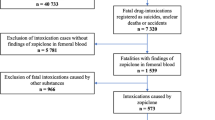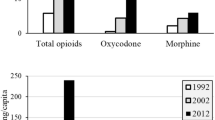Abstract
As a rapid-acting dissociative anesthetic, ketamine has been used in drug-facilitated crimes. The aim of this study is to investigate the disposition of ketamine and its main metabolite norketamine in hair after a single dose of ketamine. Four healthy volunteers were recruited into the study. Hair was collected 1, 2, 3, 4, 8, 12 and 16 weeks after a single oral dose of ketamine solution (10 mg) and analyzed by liquid chromatography/electrospray ionization tandem mass spectrometry. The wet cotton swab wiped the scalp of the subjects at 1 h, 24 h, 48 h and 1 week after administration. Maximum hair concentrations (C max) for ketamine and norketamine were 19.0 ± 6.5 and 18.7 ± 13.3 pg/mg, respectively. Except for the first week, the ratio of ketamine to norketamine in most of segments (87.5%) was greater than 1. All the cotton swab samples collected at 24 and 48 h were positive. The results from cotton swabs and the concentrations of ketamine and norketamine in hair segments collected at different times showed that some of ketamine and norketamine incorporated into hair originated from sweat and sebum on the scalp of the subjects.


Similar content being viewed by others
References
Villain M, Chèze M, Tracqui A, Ludes B, Kintz P (2004) Windows of detection of zolpidem in urine and hair: application to two drug facilitated sexual assaults. Forensic Sci Int 143(2):157–161
Goullé JP, Chèze M, Pépin G (2003) Determination of endogenous levels of GHB in human hair. Are there possibilities for the identification of GHB administration through hair analysis in cases of drug-facilitated sexual assault? J Anal Toxicol 27:574–580
Frison G, Favretto D, Tedeschi L, Ferrara SD (2003) Detection of thiopental and pentobarbital in head and pubic hair in a case of drug-facilitated sexual assault. Forensic Sci Int 133(1):171–174
Pepin G, Chèze M, Duffort G, Vayssette F (2002) Interest of hair and tandem mass spectrometry for chemical submission: about nine cases. Ann Toxicol Anal 14:395–406
Chèze M, Villain M, Pépin G (2004) Determination of bromazepam, clonazepam and metabolites after a single intake in urine and hair by LC-MS/MS. Application to forensic cases of drug facilitated crimes. Forensic Sci Int 145(2–3):123–130
Kintz P, Cirimele V, Jamey C, Ludes B (2003) Testing for GHB in hair by GC/MS/MS after a single exposure: application to document sexual assault. J Forensic Sci 48(1):195–200
Kintz P, Villain M, Chèze M, Pépin G (2005) Identification of alprazolam in hair in two cases of drug-facilitated incidents. Forensic Sci Int 153(2):222–226
Juhascik MP, Negrusz A, Faugno D, Ledray L, Greene P, Lindner A, Haner B, Gaensslen RE (2007) An estimate of the proportion of drug-facilitation of sexual assault in four U.S. localities. J Forensic Sci 52(6):1396–1400
Marc B (2008) Current clinical aspects of drug-facilitated sexual assaults in sexually abused victims examined in a forensic emergency unit. Ther Drug Monit 30(2):218–224
Schloegl H, Dresen S, Spaczynski K, Stoertzel M, Wurst FM, Weinmann W (2006) Stability of ethyl glucuronide in urine, post-mortem tissue and blood samples. Int J Leg Med 120:83–88
Pavlic M, Libiseller K, Grubwieser P, Schubert H, Rabl W (2007) Medicolegal aspects of tetrazepam metabolism. Int J Leg Med 121:169–174
Musshoff F, Madea B (2007) New trends in hair analysis and scientific demands on validation and technical notes. Forensic Sci Int 165(2):204–215
Kintz P (2007) Analytical and practical aspects of drug testing in hair. Taylor & Francis Group LLC, CRC Press, Boca Raton, FL
Henderson GL, Harkey MR, Zhou C, Jones RT, Jacob P (1998) Incorporation of isotopically labeled cocaine into human hair: race as a factor. J Anal Toxicol 22:156–165
Xiang P, Sun QR, Shen BH, Chen P, Liu W, Shen M (2010) Segmental hair analysis using liquid chromatography–tandem mass spectrometry after a single dose of benzodiazepines. Forensic Sci Int. doi:10.1016/j.forsciint.2010.04.046
Xiang P, Shen M, Zhuo XY (2006) Hair analysis for ketamine and its metabolites. Forensic Sci Int 162(1):131–134
Leong HS, Tan NL, Lui CP, Lee TK (2005) Evaluation of ketamine abuse using hair analysis: concentration trends in a Singapore population. J Anal Toxicol 29:314–318
Wu YH, Lin KL, Chen SC, Chang YZ (2008) Integration of GC/EI-MS and GC/NCI-MS for simultaneous quantitative determination of opiates, amphetamines, MDMA, ketamine, and metabolites in human hair. J Chromatogr B 870(2):192–202
Inagaki S, Makino H, Fukushima T, Min JZ, Toyo’oka T (2009) Rapid detection of ketamine and norketamine in rat hair using micropulverized extraction and ultra-performance liquid chromatography-electrospray ionization mass spectrometry. Biomed Chromatogr 23(12):1245–1250
Nielsen MK, Johansen SS, Dalsgaard PW, Linnet K (2010) Simultaneous screening and quantification of 52 common pharmaceuticals and drugs of abuse in hair using UPLC-TOF-MS. Forensic Sci Int 196(1–3):85–92
Tabernero MJ, Felli ML, Bermejo AM, Chiarotti M (2009) Determination of ketamine and amphetamines in hair by LC/MS/MS. Anal Bioanal Chem 395(8):2547–2557
Harun N, Anderson RA, Cormack PA (2010) Analysis of ketamine and norketamine in hair samples using molecularly imprinted solid-phase extraction (MISPE) and liquid chromatography-tandem mass spectrometry (LC-MS/MS). Anal Bioanal Chem 396(7):2449–2459
Peters F, Drummer O, Musshoff F (2007) Validation of new methods. Forensic Sci Int 165(2):216–224
Matuszewski BK, Constanzer ML, Chavez-Eng CM (2003) Strategies for the assessment of matrix effect in quantitative bioanalytical methods based on HPLC-MS/MS. Anal Chem 75:3019–3030
Dams R, Huestis MA (2003) Matrix effect in bio-analysis of illicit drugs with LC-MS/MS: influence of ionization type, sample preparation and biofluid. J Am Soc Mass Spectrom 14:1290–1294
Taylor RJ (2005) Matrix effects: the Achilles heel of quantitative high-performance liquid chromatography-electrospray-tandem mass spectrometry. Clin Biochem 38:328–334
Kintz P (2007) Bioanalytical procedures for detection of chemical agents in hair in the case of drug-facilitated crimes. Anal Bioanal Chem 388(7):1467–1474
Acknowledgments
The authors are grateful to the National Natural Science Foundation and National Institute Scientific Program for their financial support (No. 20975070 and No. GY0903) of this study.
Author information
Authors and Affiliations
Corresponding author
Rights and permissions
About this article
Cite this article
Xiang, P., Sun, Q., Shen, B. et al. Disposition of ketamine and norketamine in hair after a single dose. Int J Legal Med 125, 831–840 (2011). https://doi.org/10.1007/s00414-010-0534-5
Received:
Accepted:
Published:
Issue Date:
DOI: https://doi.org/10.1007/s00414-010-0534-5




